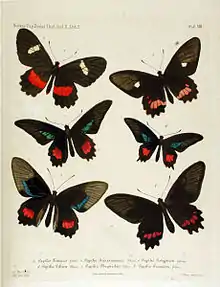Parides echemon
Parides echemon is a species of butterfly in the family Papilionidae. It is found in the Neotropical realm.
| Parides echemon | |
|---|---|
 | |
| Parides echemon as Papilio echion C. & R. Felder, 1865 and Papilio pisander C. & R. Felder, 1865 | |
| Scientific classification | |
| Kingdom: | |
| Phylum: | |
| Class: | |
| Order: | |
| Family: | |
| Genus: | |
| Species: | P. echemon |
| Binomial name | |
| Parides echemon (Hübner, [1813]) | |
| Synonyms | |
| |
It is common and not threatened. [1]
Subspecies
- P. e. echemon Brazil (Pará)
- P. e. ergeteles (Gray, [1853]) Guianas, French Guiana, Surinam, Brazil (Pará)
- P. e. empistocles Küppers, 1975 southeastern Peru
- P. e. pisander (C. & R. Felder, 1865) French Guiana
Description from Seitz
P. echemon resembles the preceding species [lysander] ; but the forewing is narrower, the outer margin being incurved in the male, straight in the female, the cell of the forewing is narrower at its extremity, the 3. radial of the hindwing is usually much nearer to the 2. radial than to the 1. median, and the fold of the hindwing in the male has no white wool. On the Lower and Middle Amazon and in the Guianas. Two subspecies. — Hubner's figures agree with the form from the Amazon: in the male echemon Hbn. (= echelus Hbn.) the blue-green band of the forewing is narrow and placed, like the white band of the female, separate from the cell. From Para to Santarem. — ergeteles Gray (= echephron Bates, echion Bates, polyphron Fldr.) has in the male a broader blue-green band, and in the female the white spot before the 2. median is contiguous to the cell, or the forewing is without spots.- female f. ergeteles Gray is the form of the female with a white area; in the female-f. pisander Fldr. the white spots are only indicated by a few white scales. From Obidos to the Rio Negro, north side of the Amazon; Guiana. — Whilst P. lysander is a swamp species and flies heavily over the wettest places in the shade of the woods, P. echemon prefers drier localities in the woods, and is often found on the flowers which hang down from the trees over the narrow paths in the forests.[2]
 in Gray 1853 (figure 1)
in Gray 1853 (figure 1)
Description from Rothschild and Jordan (1906)
A full description is provided by Rothschild, W. and Jordan, K. (1906)[3]
References
- Collins, N. Mark; Morris, Michael G. (1985). Threatened Swallowtail Butterflies of the World: The IUCN Red Data Book. Gland & Cambridge: IUCN. ISBN 978-2-88032-603-6 – via Biodiversity Heritage Library.
- Seitz, A. ed. Band 1: Abt. 1, Die Großschmetterlinge des palaearktischen Faunengebietes, Die palaearktischen Tagfalter, 1909, 379 Seiten, mit 89 kolorierten Tafeln (3470 Figuren)
 This article incorporates text from this source, which is in the public domain.
This article incorporates text from this source, which is in the public domain. - Rothschild, W. and Jordan, K. (1906). A revision of the American Papilios. Novitates Zoologicae 13: 411-752. (Facsimile edition ed. P.H. Arnaud, 1967) and online
- Edwin Möhn, 2007 Butterflies of the World, Part 26: Papilionidae XIII. Parides Verlag Goecke & Evers Verlag Goecke & Evers ISBN 9783937783277
| Wikimedia Commons has media related to Parides echemon. |